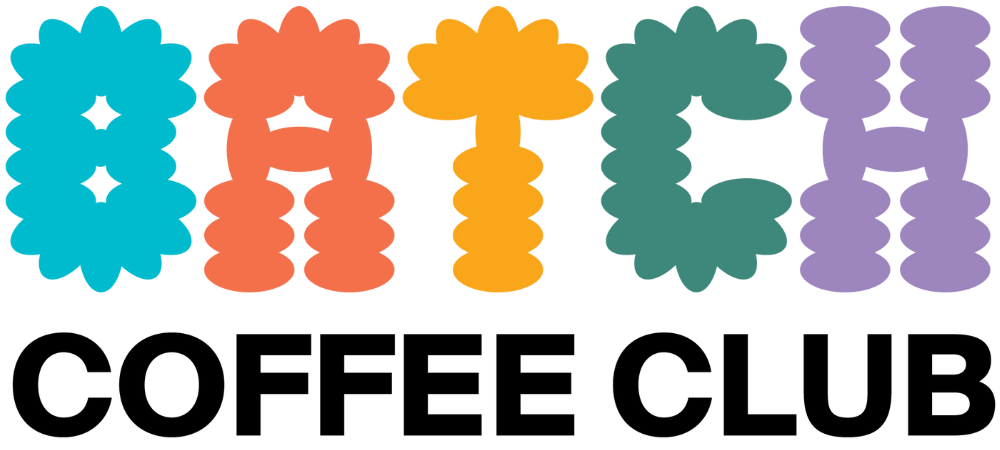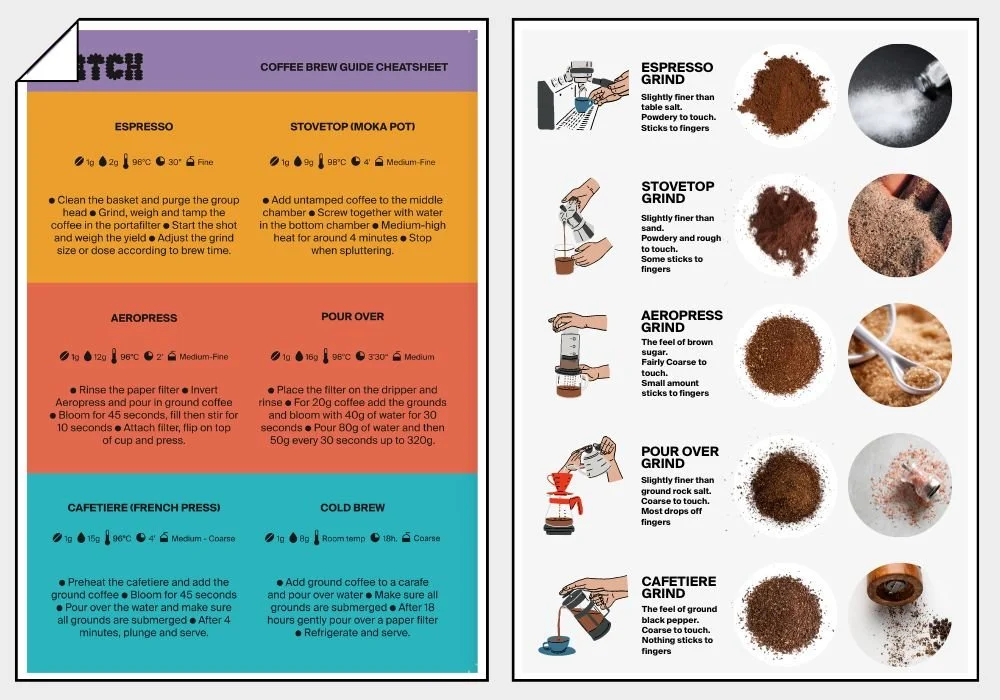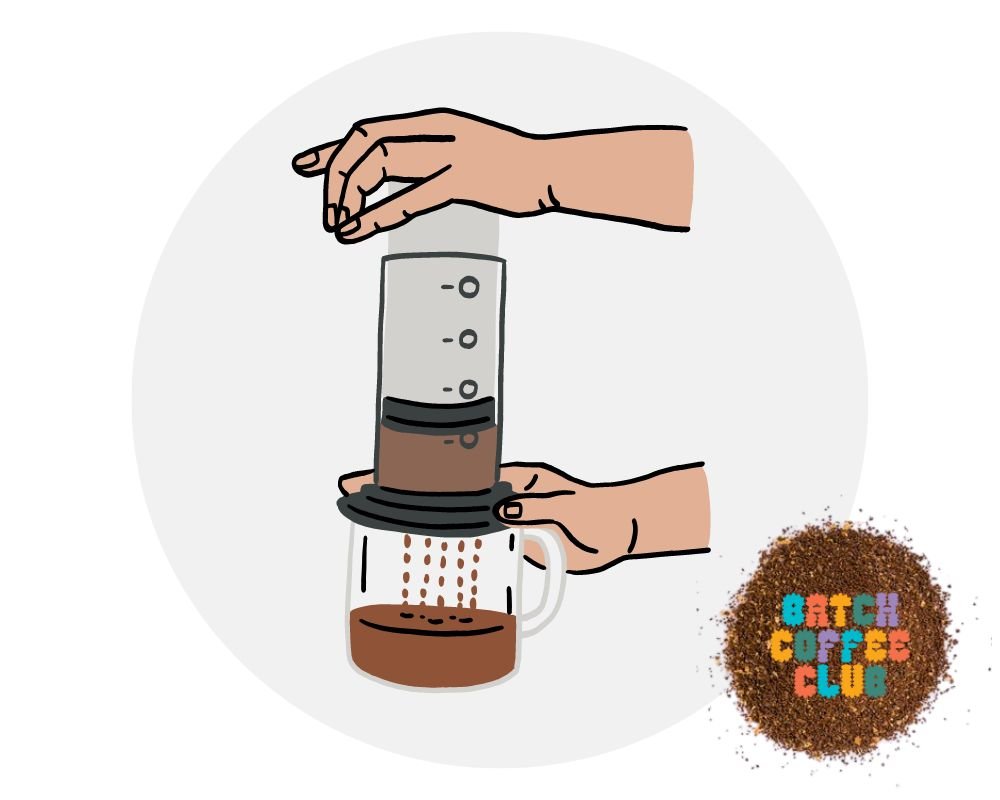Coffee Grind Size Chart
Finding the right grind size for your brew method can be frustrating.
Grinding your own coffee will seriously up your coffee game, however there are still a few things to learn and a little trial and error.
If you want to jump right in, whatever the reason. Here is our famous grind size chart, alongside our brew cheat sheet.
If you want to print or download a high res version, click the link below and it will take you directly through to the Batch Coffee Club Grind Size PDF.
Download our free Coffee Grind Size Chart PDF Here.
Use Code CAFETIERE50
Why Trust Me?
I’m Tom and I have been working in the coffee industry for over 10 years, starting my journey as a barista in Australia, working on coffee farms in South America and roasting coffee in The UK. Today I review and write about speciality coffee. I am the founder of Batch Coffee Club, which showcases the very best coffee from around the world.
Checkout our award-winning coffee subscription.
First of all I will just highlight a few basics around grinding before I jump into different coffee grind sizes in more depth.
Why do we grind coffee?
Coffee beans start off as a fruit that grows in coffee producing countries.
It is then roasted into the coffee beans that we are familiar with. The process of brewing coffee is adding hot water (except for cold brew) to coffee grounds and extracting some of the soluble compounds.
If the coffee was not ground and instead whole beans very few compounds would be able to be extracted.
Under/Over Extracted coffee.
Under or over extracted coffee are terms that are used in the coffee industry to describe the coffee once brewed.
An under extracted coffee is one in which not enough of the soluble compounds have reached the end cup after the brewing process, this can be for various reasons, one of which is that the grind size is too coarse. Under extracted coffee can taste sour, unbalanced and weak.
An over extracted coffee is one in which the brewing process has extracted too much of the soluble compounds into the end cup. This again can be for various reasons such as water temperature or brew time but also a grind size that is too fine. Over extracted coffee can taste bitter, unbalanced and strong.
How to grind coffee/dial in?
The process of grinding coffee and dialling in your brew method does slightly change for each brew method.
However there are a few basic points that are always important to keep in mind.
Firstly, if you have nothing to previously go off aim for what you gauge as our recommended grind size for your brew method.
Make sure you then measure all other variables exactly as it describes on your particular brew recipe.
How to dial in coffee by our mates over at European Coffee Trip.
Now brew your coffee and according to our description above of under extracted or over extracted coffee then adjust the grind size accordingly (if the coffee is over extracted then make the grind coarser or finer if it is under extracted).
You may also be able to see how to adjust the grind by how long the coffee takes to extract, if it is too fast then make the grind finer, too slow then coarser.
One important thing to keep in mind is to only adjust one variable at a time. If you are adjusting the grind size, make sure you keep the dose (volume of coffee), water temperature, water volume, etc constant.
Why do you need a burr grinder?
Burr coffee grinders are one of the two types of grinders, the other being a blade coffee grinder.
Burr coffee grinders operate with coffee passing through two burrs which rotate at your chosen distance to produce a consistent grind.
Blade coffee grinders essentially blend the coffee and although you will never be able to achieve a consistent grind, the longer you grind for the finer the coffee becomes.
If you are looking to purchase a grinder I would highly recommend a burr coffee grinder. Consistent grind size is very important when it comes to brewing quality coffee. This is probably best illustrated by looking at what happens when you brew non-consistent grind sizes. As there are coarse and fine grinds mixed together, you will end up with a brew that is both over and under extracted (which isn’t very pleasant).
Grind sizes for brew methods
Here are some of the most popular brew methods and the way that we go about grinding coffee.
What is the best grind size for espresso?
Espresso is best brewed with a fine grind size, that is sort of powdery and the consistency slightly finer than table salt.
Espresso is the hardest grind size to get just right because there are many variables to take into account that can affect the brew when slightly altered.
Baristas are constantly altering the grind size throughout the day as the espresso machine heats up, the burrs change temperature or the humidity affects the coffee beans.
Find out what we look for in an espresso grinder.
What is the best grind size for Moka Pot?
Moka Pot grind size on our chart is around a medium fine setting.
This should be slightly powdery and similar to sand.
Be careful when adjusting the grind size for a stovetop to not make the coffee grind too fine, this may lead to the brew water not being able to pass through the grounds and burst out of the seal.
What is the best grind size for Aeropress?
Typically Aeropress grind size is around medium to fine.
Aeropress grind size is a little easier to configure than espresso grind.
There are also many different recipes that call for slightly different grind sizes so there is a bit more ‘give’ with the coarseness.
You will be able to gauge whether you need finer or coarser by either the taste of the coffee (under/over extracted) or by the ease of the plunge. If you have an Aeropress and are looking for a grinder then find out what we deem as the best Aeropress coffee grinder.
What is the best grind size for pour over?
Pour over coffee grind size is typically medium and resembles something similar to ground rock salt.
The biggest give away apart from the taste of your brew when it comes to deciding whether to adjust the grind size for your pour over is the brew time.
If the brew water seems to drip straight through the coffee grounds then make the grind finer or if the brew water just sits on top of the grounds then make the coffee coarser.
What is the best grind size for Cafetiere?
A cafetiere is best brewed with a coarse grind setting.
The coffee grounds may feel like ground pepper. As a cafetiere extracts coffee by submerging the grounds in the water, the coffee grounds have to be large enough so the coffee doesn’t become over extracted.
You may also be able to tell by the ease of plunging the cafetiere, similar to Aeropress if the coffee grounds are too fine then it may be difficult to plunge.
Is the coffee grind size important?
Well hey, it’s coffee. This isn’t life or death here.
However, if your coffee grind size isn’t in the region of optimal coarseness for your desired brew method then you will end up with either a weak under-extracted coffee or an over-extracted bitter tasting coffee.
If the coffee is ground far too fine for your brew method (particularly if you brew your coffee in a Moka pot or espresso) you may not even be able to extract any coffee.
This is because the water will not be able to pass through the fine grounds and can affect the functionality of your coffee maker.
How to tell the grind size in pre ground coffee.
If you purchased pre-ground coffee and it doesn’t say anything about how coarse the coffee is ground, then checkout our coffee grind chart above which should give you an idea of which brew method it is best suited to by comparing to household products such as salt or sugar as well as a brief explanation of how the coffee grounds should taste.
If you still have no idea of the grind size then you can brew a coffee in your chosen method. If the coffee is bitter and over extracted then it is too fine or under extracted and weak then it is too coarse.
FAQs
-
If you brew your coffee with fine coffee, then technically your coffee will taste stronger. However there are a few things to keep in mind here before you start purchasing Turkish coffee grind for your cafetiere.
Firstly, bear in mind that the reason we advise you to grind coffee as we have suggested in our coffee grind size chart is because these levels produce the most optimally extracted coffee for each method. If you grind your coffee too fine in order to make strong coffee then you will end up with either a bitter tasting coffee, coffee grounds in your cup or even no coffee at all.
If you are looking to make strong coffee (even if it does taste bitter) then make sure you grind your coffee finer than usual but not too fine.
-
Essentially a blender, a blade coffee grinder uses, you guessed it - a blade, to grind the coffee beans. Unlike burr coffee grinders where the beans pass through the burrs and the grind size is altered by changing the distance between the burrs whereas blade grinders use time to alter the grind size.
Each blade grinder is different, however it is worth grinding the coffee in intervals when you first start, to decide the correct grind size for your brew method.











